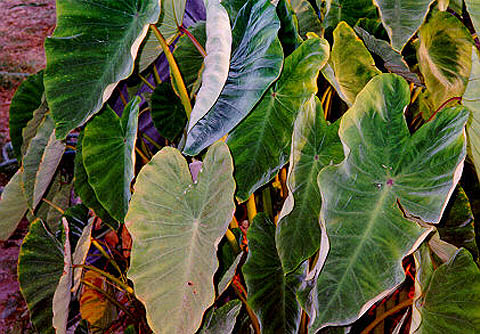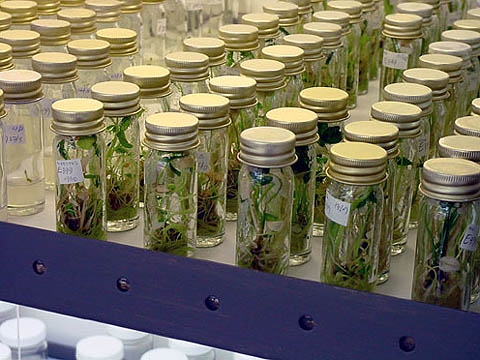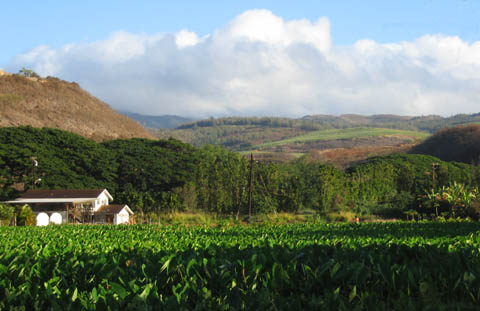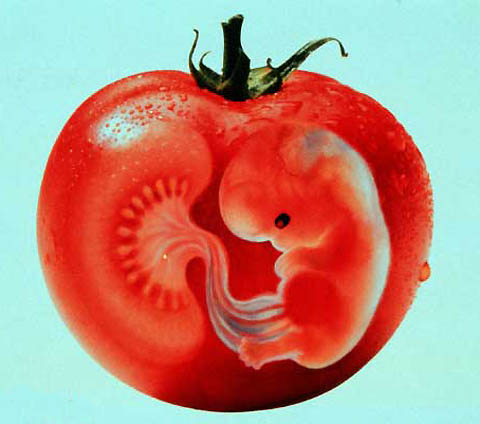SUBJECT: EXPERIMENTS ON TARO
SOURCE: JERI DI PIETRO ofstone@aol.com
POSTED: 23 JUNE 2006 - 1:45am HST
Patents
released on Sacred Hawaiian Taro plants

|
by Jeri Di Pietro on 21 June 2006 After 6
months of efforts in Hawaii the University of Hawaii finally dropped 3
patents on the Hawaiian taro, or Kalo, staple food and culturally
sacred plant in Hawaii. KGMB What can you do? Well, writing letters with your opinions about this to the newspapers would be great to keep the media going. Here are two articles that you could send some corrections or comments to: This "opinion" piece in the Honolulu Advertiser asks if it was the best thing or not to drop the patents. If you could write a response to the Advertser it would be great: Click here. Then there is this one that talks about disease being a big threat to taro. We all know a bigger threat is diversion of water (due to development), high land taxes and a lack of farmers. One of the cards UH has been using is that taro farmers really need the GMO taro, although most of the farmers have been resistant. This is a good opportunity to talk about the bigger agricultural and cultural issues that really surround the lack of poi and kalo in Hawaii and the fact that most farmers don't want their culture and markets threatened with GE taro. Here's a link. by
Sara Sullivan for Hawaii SEED |
SUBJECT: EXPERIMENTS ON TARO
SOURCE: JERI DI PIETRO ofstone@aol.com
POSTED 3 JUNE 2006 - 9:00pm HST
UH will
assign taro patents to Hawaiians

Painting 'The Planter" by Herb Kawainui Kane.
Click on image to see more.
| UH will assign taro patents to Native Hawaiian
community by Gary Ostrander on 2 June 2006 on UH News The University of Hawai‘i at Manoa announced today that it would assign three patents related to development of disease resistant taros to the greater Native Hawaiian community. The patents in question arose from work conducted by a UH faculty member in the 1990s, at the request of Samoan taro growers, to address the near eradication of their taro crops to a leaf blight. The researcher developed a number of cultivars from crosses of Hawaiian and Palauan taro strains. The latter were obtained specifically for this purpose with the consent (including proper permitting) of Palauan taro growers and Palauan government officials. Using traditional breeding techniques, the UH researcher produced three strains that were shown to have increased disease resistance. The patents were granted in 2002. “The University of Hawai‘i has a strong desire to maintain appropriate respect and sensitivity to the indigenous Hawaiian host culture,” said UH Manoa Vice Chancellor for Research Gary K. Ostrander. “Taro is unique to the Hawaiian people in that it represents the embodiment of their sacred ancestor. As such, it is appropriate to make an exception to our standard policy of holding all patents.” Discussions are under way within the Hawaiian community on the appropriate entity to receive the patents.
|
SUBJECT: TARO EXPERIMENTS
SOURCE: JERI DI PIETRO ofstone@aol.com
POSTED: 19 MAY 2006 - 9:00am HST
Taro
Patent stirs protest at UH

taro plant cultures in genetic laboratory
| Protestors
Chain Doors To UH Medical School 18 May 2006 on www.yahoo.com Hawaiian activists locked the front and back entrances to the University of Hawaii's medical school on Thursday in protest to the school's patents on taro. The UH Board of Regents was set to meet at the building about other topics. The University's College of Tropical Agriculture was granted patents for taro in 2002. Hawaiian groups said the university did not invent taro and therefore has no right to own or license it. Activist Walter Ritte led the group. Taro is owned collectively by Hawaiians and therefore UH should return the three varieties to the public domain, according to Ritte. "We are saying you cannot own our taro. You cannot own our taro. It's so simple," Ritte said. University researchers created the new taro and UH said under its contracts with professors it needs to protect their intellectual property. The new taro is not genetically modified, but created by traditional cross-breeding, officials said. UH officials said the new taro is given to farmers for free but under the licensing agreement if a farmer makes a profit on the taro, the university gets to keep 2 percent. The group unlocked the chains to the entrances at 9:30am. after regents agreed to meet with the group at a later time to discuss the taro issue. The protest did not affect classes. Students and faculty were able to enter through other locations. |
SUBJECT: TARO EXPERIMENTS
SOURCE: JERI DI PIETRO ofstone@aol.com
POSTED: 14 JANUARY 2006 - 9:00am HST
GMO
Free Hawaii hold press conferences

The largest taro fields in Hanapepe Valley,
on Kauai, are a stone's throw from GMO corn fields
|
Activists oppose UH's patenting of taro plants Arguing
that the patents were wrongly obtained, local and national activists
opposing the patenting of taro plants are asking the University of
Hawaii to relinquish the rights it owns for three varieties of the
traditional Hawaiian food staple.
This article is a result of our GMO Free Hawai`i press conference that was held outside the Pacific Rim Biotech Conference at the Hilton Hawaiian Village in Honolulu on January 12, 2006. - Jeri Di Petro Quietly, Hawaii serves as world's biotech lab |
see also
Island Breath: GMO crops & superweeds
Island Breath: BioPharming Lawsuit
Island Breath: GMO Algae in Hawaii
Island Breath: China & Kraft GMO
Island Breath: GMO Free Kauai
Island Breath: GMO free Molokai
Island Breath: Mendocino GMO ban
Island Breath: GMO Experiments
Island Breath: GMO Rice
Island Breath: GMO in Hawaii
Island Breath: The Future of Food
Island Braeth: Percey Schmeizer
Pau
